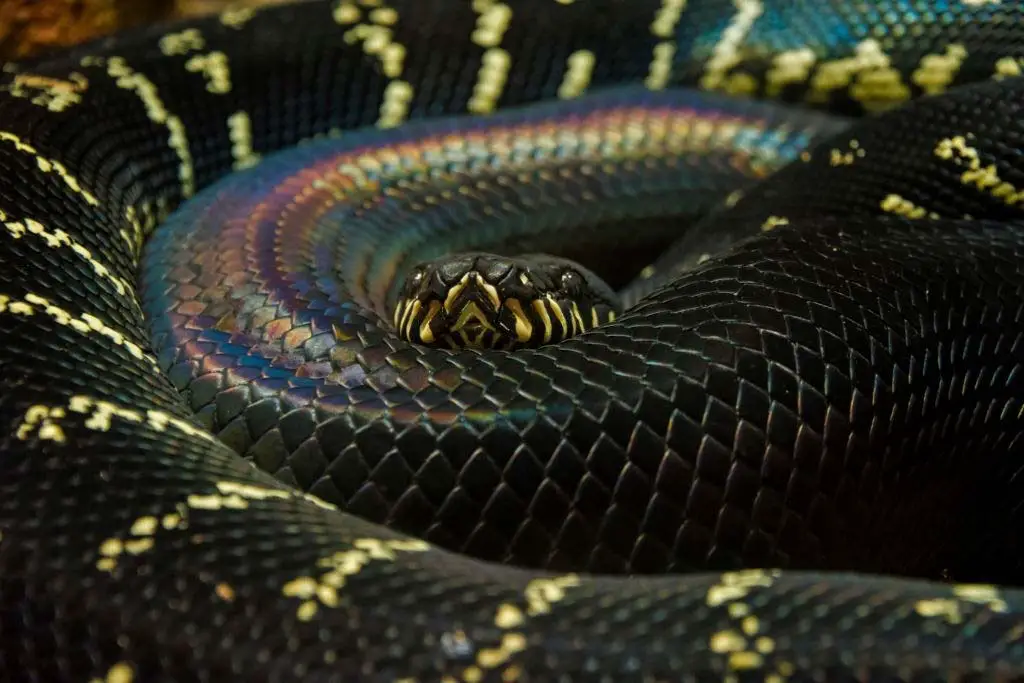Boelen’s python (Simalia boeleni) is a phenomenally beautiful species of snake. At birth, they are red with light banding and then they morph into this stunning iridescent black creature that is revered among reptile enthusiasts.
Not a lot is known about this creature. However, this guide has compiled facts from reputable owners across the globe to bring you the best care tips there are.
We do recommend that caring for this snake only be taken on by intermediate to advanced snake owners.
| Common Name: | Boelen’s Python, Papa Graun Moran, Black Python |
| Scientific Name: | Simalia boeleni |
| Natural Habitat: | Mid-mountain range in Papua New Guinea |
| Adult Size: | 8 feet on average |
| Lifespan: | 15 – 20 years |
| Diet: | Rodents and birds |
| Experience Level: | Advanced |
| Enclosure Size: | 6 feet long x 3 feet wide x 2 feet high |
Reptile Overview
The Boelen’s python comes from the mountains of Papua New Guinea. The Wola tribe believes that the god, Burum, fled from a vicious fight and shed his beautiful feathers until all that was left was the sleek black and white body of a snake.
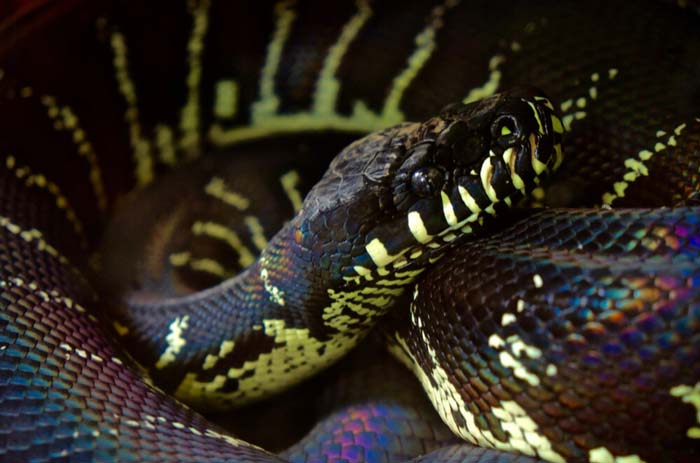
The Prince of Pythons
The locals revere this snake which adds to the reasoning of why the local government made it illegal to hunt or kill these snakes and put them on the list of zero-quota exports.
The legal Boelen’s pythons that you will get will therefore have been sourced from captive breeders. This means that they are very rare and very expensive.
Do not take part in the illegal pet trade. Be responsible and research your breeder before purchasing your snake.
These pythons need specialized care and new owners need to be aware of the time and space this snake will take up.
Appearance
As hatchlings, these snakes are red in color and have bands of white that go down the body.
As the snake ages, they lose most or all of their red coloring until their bodies have the sleek black pigmentation that they are famous for and their white bands shrink a little and turn yellow.
There is no clear sexual dimorphism between the males and females that have yet been recorded.
On average they reach 8 feet in length and have a significant girth to their bodies. There are reports of Boelen’s pythons reaching 10 feet and an unconfirmed case of a 14-foot specimen from Eastern New Guinea.
Their heads are the typical python shape with a blunted snout that widens towards to neck and then narrows where it meets the body.
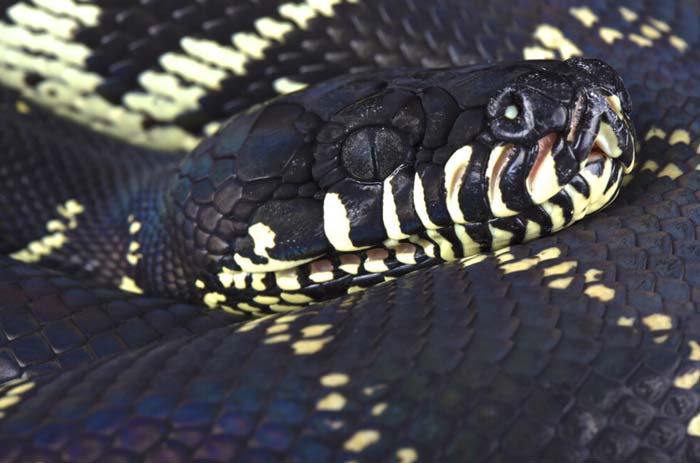
Their adult bodies are jet black with bright yellow banding. Their scales have an iridescence in the right lighting. The Boelen’s pythons’ scales will show you every color of the rainbow as it moves about its enclosure.
Their bellies match their banding and are a bright yellow color in adults. The further down the body you go the more predominant the black coloration becomes.
The snout and lower jaw have vertical white/yellow scales that alternate with black ones which creates a pattern. Their eyes sit on the sides of their heads and have vertical slits.
These facial features give the Boelen’s python a very inquisitive look. This look is backed up by their curious natures.
Temperament
Handlers state that this is a calm snake if handled correctly. They are not known to be aggressive and will shy away when met with a threat instead of attacking.
However, they are big constrictors so if they bite be aware that it will be a painful one.
They are incredibly curious animals and will escape their enclosure if given the chance. We recommend their doors be locked carefully.
However, this curious behavior makes for wonderful viewing and handling as the snake really does appear to seek out new smells just because they are there.
This does not appear to be a prey-driven curiosity; however, care always needs to be taken if the scent of their regular prey item is on you. They could confuse that scent and bite without any aggressive behavior indicators.
Behavior
In the wild, the Boelen’s python will shy away from human contact, whether they are juveniles or adults. In captivity, they can be a little flighty when they are young.
Very little is known about their behavior in the wild so there is a need to provide a general 12/12 light/dark photocycle and pay attention to when your snake is most active.
You should feed them during the most active hours and handle them when the snake is most relaxed.
The Boelen’s python is a mostly terrestrial snake. However, they do venture into the trees that can sustain their considerable weight so they are called semi-arboreal.
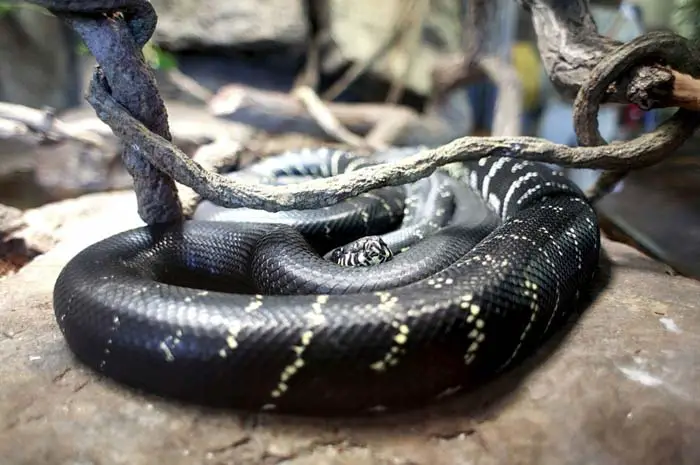
This means that your enclosure set up will need to accommodate for this.
They are non-venomous constrictor snakes so while their teeth may be plentiful and sharp, Boelen’s pythons are not venomous.
In the wild, they hunt their natural prey of rodents and quail on the ground but do venture into the trees where they are known to eat cuscus (a tree-dwelling marsupial.)
Lifespan
The documented average lifespan for Boelen’s python is 15 years. However, the oldest (and still living) captive specimen is 23.
This is a big and long-lived snake so make sure you are up to the task before you get one.
Enclosure
The Boelen’s python gets big and they need the space to roam. We recommend an enclosure no smaller than 6 feet long x 3 feet wide x 2 feet high for an adult.
REPTI ZOO Large Glass Reptile Terrarium
Your python should be able to comfortably stretch out in the enclosure. Remember, it spends its whole life in a box, it should at the very least be comfortable.
The enclosure needs to have appropriate ventilation as stagnant air will cause respiratory issues.
The required humidity is high enough to cause wood to rot so we do not recommend a fully wooden enclosure.
The enclosure needs to be long enough so your snake can have room to move through an appropriate temperature gradient.
This includes movement through the vertical aspect as well:
- Place sturdy branches or other perches in the enclosure that will give your snake ample space to climb to different temperature and humidity spots and explore the vertical aspect of their enclosures.
- If you are using natural wood then we recommend you sterilize it before putting it into the enclosure. You can do this by boiling it in water and letting it dry out completely.
- Make sure that the wood does not contain harmful chemicals or oils in it and is not too rough on your Boelen’s scales.
As mentioned before, the Boelen’s python is a curious creature and will escape if given the chance. Make sure all doors and/or lids are secured at all times.
You should do a spot clean of the enclosure once a week and do a full cleanout and sanitization once a month. A dirty enclosure (literally) breeds bacteria, parasites, and mold that will kill your snake.
Substrate and Enrichment
Newspaper, paper towels, and butcher’s paper are always our go-to forms of substrate. They are effective, cheap, and easy to clean.
You can use Cypress mulch or Aspen shavings as long as they stay appropriately moist as the dry substrate can damage your snake’s scales.
We would recommend agitating the substrate daily as this aerates the substrate to prevent mold from developing.
Never use pine or cedar shavings.
They contain oils that are toxic to your snake. They will cause skin irritation and respiratory issues.
Spot clean your substrate daily when you agitate it. Leaving fecal matter in the enclosure will breed harmful bacteria and can re-infect your snake with parasites.
Place hollow logs, rocks, and other forms of enrichment on the floor of the enclosure for your snake to explore. However, be careful to not over-crowd the base of the enclosure as this can stress your snake.
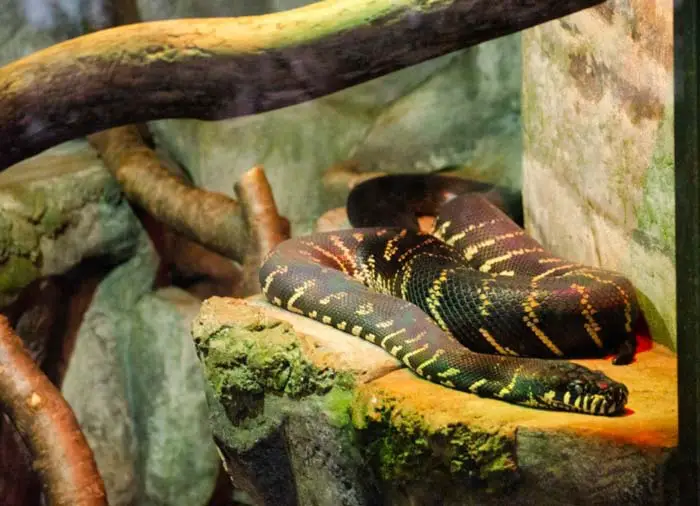
Natural vegetation can be used to decorate the enclosure as well as provide a source of stable humidity. However, this is not a must-have.
We do recommend that you have some type of foliage (whether natural or synthetic) in the branches that run through the vertical aspect of the enclosure. This will provide your snake with a sense of security and more places to de-stress.
Temperature
We recommend using an under-tank heating pad that is controlled with a thermostat. It is important to have thermometers placed on the coolest side of the enclosure and in the warmest spot.
We recommend to use VIVOSUN Reptile Heating Pad with Digital Thermostat.
VIVOSUN Reptile Heating Pad with Digital Thermostat
- Cool Side: 68°F
- Warm Side: 85°F
- Basking Area: 90°F
When your adult snake is in its adult-sized enclosure you can change the heating pad so that it covers some of the bottom, all of one side, and some of the top of the enclosure. This will provide it with a vertical and horizontal temperature gradient.
Your Boelen’s python can happily bask in high temperatures because its enclosure should be big enough to have the range necessary for it to ectothermically regulate its bodily functions.
There should be a hideaway on the coolest side of the enclosure and the warmest side. The hideaway needs to be big enough for the whole snake to fit in and small enough that your snake feels snug and safe.
We recommend a small lamp of no more than 60 Watts in the basking spot. However, the bulb (or ceramic heat emitter if you choose) must be in a protective dome to reduce the risk of your snake burning itself.
Remember, this is a curious snake and it will poke its nose where it can, even if it means it will get hurt.
Always do your set up before you bring your snake home. Fiddling with the temperature can be fatal if you do it while the snake is in the enclosure and trying to settle down from its big move.
Lighting
Unlike most snakes, your Boelen’s python does require special lighting. We recommend a light source that has full-spectrum UV lighting.
The special lighting will benefit your snake’s overall health and immunity as well as bring out its iridescent shine.
Your Boelen’s python needs a 12/12-hour light/dark photocycle. It is a good idea to have the light and heating lamp on timers, like Zilla Digital Timer, to avoid mistakes and disruptions to your snake’s schedule.
You should not have the enclosure in a room that receives lots of artificial light in the evenings as that would disrupt their photocycle. In the same way, the enclosure should not receive any direct sunlight as this will overheat the enclosure and kill your snake
Humidity
Your enclosure should be equipped with a quality hygrometer to keep a careful eye on humidity levels. Our recommendation is Zoo Med Labs Digital Hygrometer & Thermometer.
The average humidity levels should sit between 70% and 80%. You can achieve this by lightly misting the enclosure and substrate once a day or using automatic fogger like REPTI ZOO Reptile Mister.
However, you need to be careful not to super-soak your snake as this will encourage wrinkled scales and fungal growth.
During shedding time, we recommend putting dampened sphagnum moss in the hide on the warm side of the enclosure. This provides a small and localized boost in humidity to aid in the shedding process.
Galápagos Terrarium Sphagnum Moss
Diet
Water: Your Boelen’s python needs a lot of water. The water bowl needs to be big enough for the snake to rest its full body in, but not deep enough that the water will spill over the sides and drive the humidity levels up.
The water needs to be changed daily.
Food: Your Boelen’s python might be extremely hesitant to eat at first; however, when it does start feeding it will take prey as often as you give it. So be cautious of overfeeding your snake.
We recommend feeding juveniles mice and rats and as the snake gets to its adult size adding appropriately sized rabbits and quails will provide necessary nutritional variation.
Juveniles can be fed one prey item once every 7 days and adults one prey item once every 10 days. We suggest using our prey sizing formula:
Largest point of girth of prey item = Largest point of girth of snake (not head)
We never recommend live prey for many reasons:
- The cost involved in keeping the prey item alive and healthy is substantial.
- The chance of parasite transmission is high.
- The chance of the prey item damaging the snake is high.
We always recommend frozen/thawed (F/T) prey items. This way you are sure that the prey item’s natural bacterial and parasite load is killed during the freezing process.
When it comes to feeding your Boelen’s python, simply take the frozen prey item and place it in a bowl/bucket of hot water until it is completely thawed. Serve it to your snake warm and wet.
NEVER feed your snake partially frozen prey as the temperature difference will kill them.
Handling
Boelen’s pythons are great for handling because they are so inquisitive. However, their size and weight can be misleading because they are quite delicate.
Always sanitize your hands and wear clean clothes before handling your snake and between handling different animals. Snakes are prone to bacterial infections and cross–contamination is a big cause of these infections.
Care needs to be taken not to squeeze or grasp the snake as it goes exploring. Rather maintain active handling instead of just trying to sit with it on your lap.
Boelen’s pythons are heavy adult snakes so make sure you support their body appropriately.
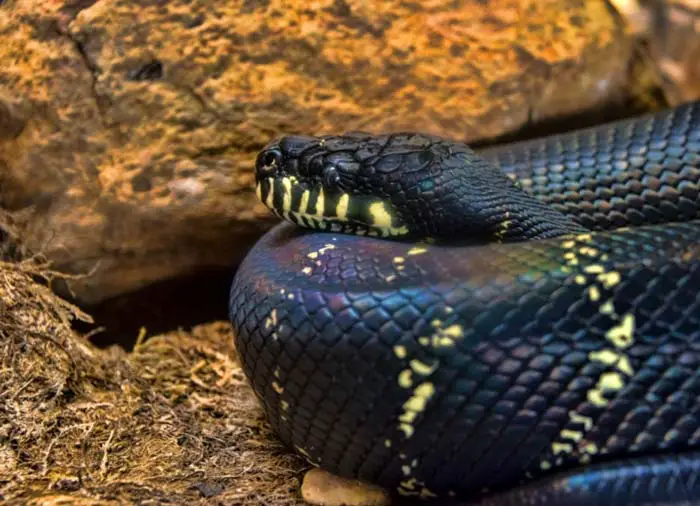
These snakes are quite intelligent and you will be able to form a kind of bond with them over time. We recommend handling your snake once a week for less than an hour.
Never handle your snake for 24 hours before, during, or for 48 hours after feeding. This will cause your snake to stress and refuse or regurgitate its food.
When you get into the rhythm of feeding and handling your snake, you will be able to read its body language and the handling experience will be incredibly satisfying.
Potential Health Issues
These snakes suffer from the common health issues that most snakes suffer from.
Obesity:
- Fat snakes are not funny snakes.
- Obesity puts strain on the heart and liver and is fatal if left untreated.
- Maintain a structured feeding schedule as these snakes will take food whenever it is offered.
Parasites:
- Wild-caught specimens will come with a high parasite load which needs to be treated immediately.
- Captive-bred specimens may come with a parasite load and it is always good practice to treat for parasites proactively.
- Mites are a common external parasite problem and are an indication of poor enclosure maintenance. The snake needs to be treated immediately and the enclosure needs full sanitization.
Scale and Mouth Rot:
- Scale and mouth rot occurs because of a bacterial or fungal infection brought on by too high humidity levels.
- Get your python to the vet and adjust your humidity levels accordingly.
- We suggest a full sanitization of the enclosure happen as soon as possible.
Respiratory Issues:
- Due to too high humidity, your python can develop an infection in its respiratory tract.
- You will notice it bubbling or gurgling and there will be an excessive amount of mucus around its nostrils and mouth.
- Seek immediate medical attention for your snake and adjust your humidity levels.
Breeding
There is very little information on the captive breeding of Boelen’s pythons. However, the best way to get successful clutches of eggs is to mimic what would happen in the wild.

We suggest a period of brumation. We suggest the temperature is lowered to 60°F on the cool side of the enclosure for a period of 3 months that coincide with the winter months.
Gradually increase the humidity to 85% to mimic the increased rainfall they would experience at this time. Your pythons should go off feed while they are being brumated.
At the end of their 3-month period, slowly increase the temperature and reduce the humidity to normal levels. Offer your pythons a slightly smaller-than-normal prey item.
Now is the time to make introductions between your male/s and your female. We suggest doing this in the female’s enclosure as this is where her pheromones will be the strongest.
Leave the pythons together for a week at a time but keep an eye on them for aggression. Remove the male every week and feed them both, then reintroduce the male 48 hours after feeding.
Reintroduction will spike interest in the female and hopefully encourage mating. When the female becomes gravid (pregnant) she will go off of food and there will be a bulge in her belly.
Remove the male permanently and return the enclosure settings and feeding schedules to normal. The female will go through a pre-lay shed so keep a careful eye on the humidity levels so she is not under extra stress.
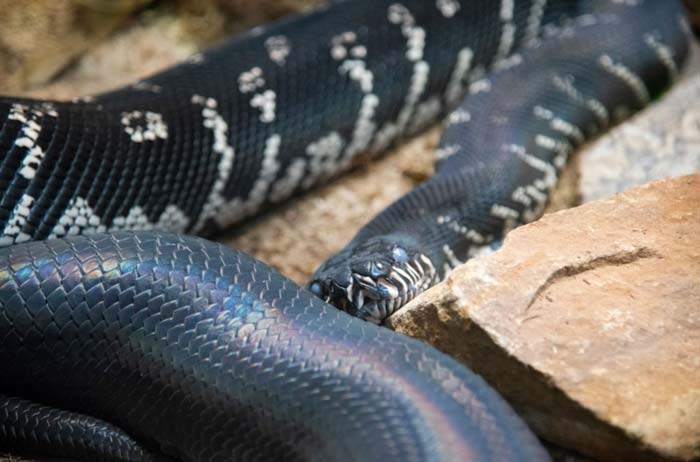
The female will lay her clutch of 9 to 14 eggs soon after her shed. We suggest putting a box lined with damp sphagnum moss in the middle of the enclosure that is big enough for her to get into and turn around in.
When she has laid her eggs her parental duties end. We suggest removing the eggs and incubating them at 88°F with a humidity range of 85% – 90%.
In 70-days you will see the captive-bred baby Boelen’s pythons that you have helped bring into the world emerge from their shells. Do not house them together and resist handling them while they still so young and fragile.
The neonates can be housed in 12x12x12 inch tubs with suitable ventilation, humidity, and temperature gradients. However, when they start growing their enclosure will need to as well until it reaches the adult-sized one described previously so be prepared.
They should take food fairly quickly and easily after their first shed. Offer them a small pinky once every 5 – 7 days while they are growing and then follow the prey-size formula.
Conclusion
Boelen’s pythons are shy and mysterious black beauties. They are wonderfully calm and curious creatures to own; however, their care is quite specialized and requires some serious experience.
These pythons are rare in the industry because it is illegal to catch and export the snakes from their endemic homeland of Papua New Guinea. So, make sure that the person you are getting your Boelen’s python from is reliable and reputable.
We wish you all the luck and success in the world and “herp” you have a wonderfully long journey with your new best friend.
Related:

